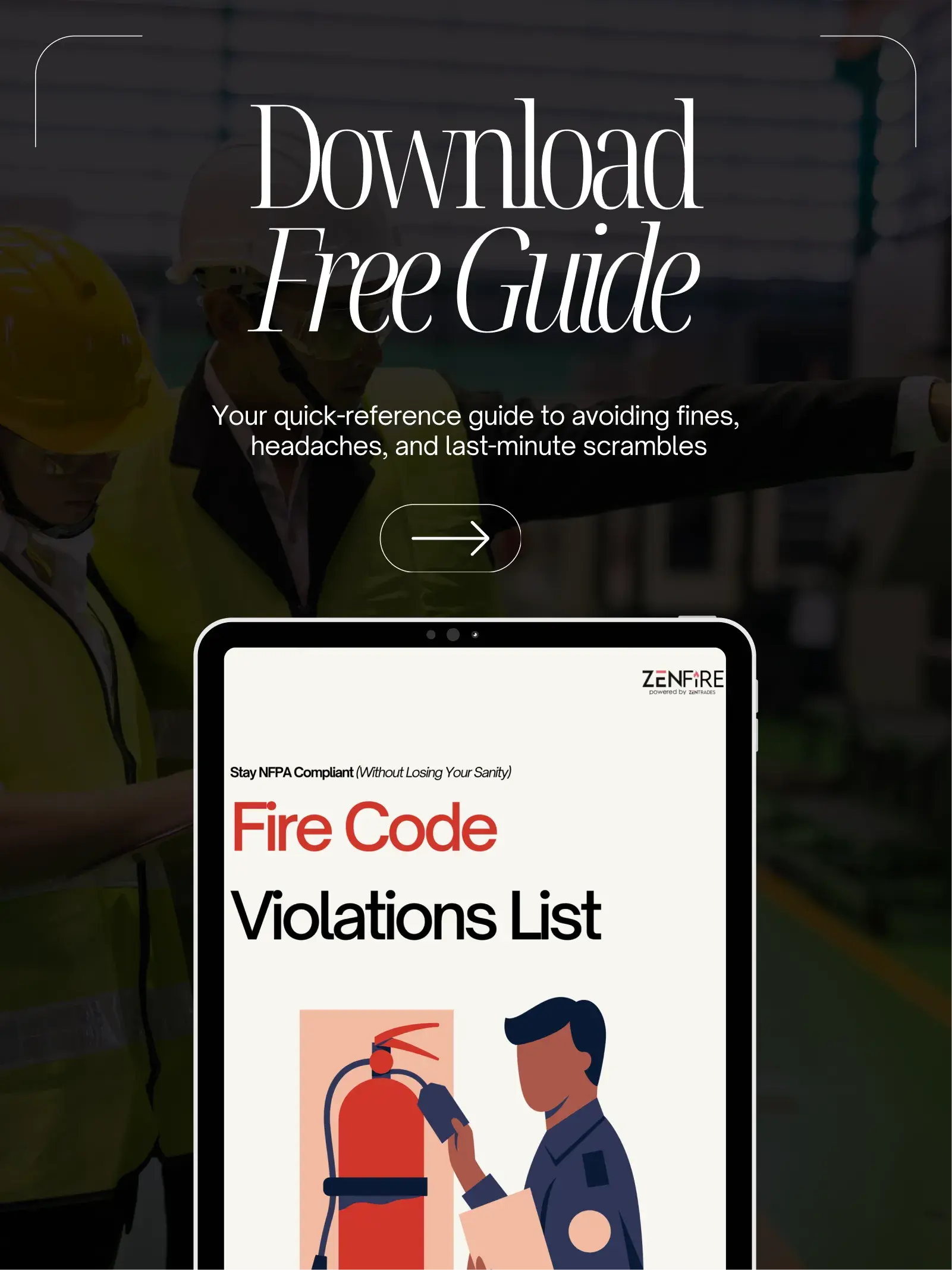Understanding Fire Code Violations: Everything You Need To Know
- Field Service Management
- 9 Min Read
Fire codes are the framework that supports your building toward adequate and preventive fire safety protection. Fire codes provide a comprehensive and detailed overview of fire safety and protection guidelines that answer our ‘what,’ ‘how,’ and ‘when’ questions, like what to do, how to go about it, and when to proceed with the action. Non-compliance with these fire codes can result in a grieve penalty. And, if the situation worsens, you might face a severe fire emergency, which will not only cost lives but cause extensive property damage on a large scale. The damage could be so remorseful that adhering to the fire codes could have seemed like a more accessible and more intelligent solution.
In this blog, we will discuss what fire codes are and how important they are to ensure the life safety of individuals. We will also cover grounds on the common fire code violations and how to report them to enable a safe and secure environment.
Here What We Cover
Are Fire Codes That Important?
In simple terms, fire codes are preventive measures that help dissuade accidental fire emergencies caused by casual mistakes. They are constructed in a way that serves the sole purpose of providing vigorous fire protection for your property and its inhabitants. Fire codes establish proper regulations for all fire safety measures, such as maintaining adequate egress, electrical systems, effective and efficient fire alarm systems, material storage, and overcrowding situations.
However, adhering to fire codes does not mean you are cent percent secure and shielded from accidental fires. But complying with them can effectively slow down the damage spread and aid in lesser damage and losses. And it’s not just your building that you are liable to care for. You are responsible for your community as well. It’s unfair for your community to face the consequences of someone who failed terrifically to care enough for their own safety, let alone for the individuals inhibiting around them. Hence it’s not just imperative that you take care of your own establishment but also take observational notes on fire code adherence along with its violation around you.

Use our free estimate template now
Make winning quotes in minutes—for any industry and any job.
Why Implement Fire Codes?
Fire codes encompass a wide range of topics, such as building structure and layout, fire alarm systems, egress and evacuation planning, and many more. You wouldn’t want your building to be susceptible to extreme fire dangers due to a lack of proper emergency response and evacuation plans. Fire codes aid in setting up structured guidelines for all your systems to facilitate a quick evacuation while avoiding spreading fire to other parts. These also help keep the chances of injuries to a minimum due to the lack of regulations, which can cause significant panic among the people. Fire codes effectively contribute towards less property damage and saving lives, all while catering to the life safety of your building occupants and other individuals.
Why Should You Report A Fire Code Violation?
To understand why fire code violations should be reported, it’s important to understand why it is vital to have fire codes in place. With the advent of new and cutting-edge technologies in 2024, the risks have also elevated to a more advanced level. Establishing fire codes makes sure that the basics of fire protection and prevention are covered, not just for you but for every individual inhabiting and around your property.
Imagine there’s a building right opposite your complex. The structuring, layout, and occupancy type of it demands a lot more than the fire safety mechanisms they have in place. This deficiency does not just concern the occupants there but also you and other neighboring units around it. Now, a fire accident occurred due to non-compliance with the essential and required fire codes in that particular establishment. The damage does not pertain only to that specific building but also to you and other individuals around it. The panic, the harmful smoke, the spread of damage, the chaos – all of it is now a burden for the entire community. And it’s all because someone considered fire codes too unimportant to adhere to and risk the safety and health of the whole community.
Role of Regulatory Bodies
Regulatory bodies like NFPA, ICC, and OSHA provide regulations and guidelines on best practices for keeping your environment fire-safe and ensuring the safety of all individuals. Guidelines provided by these bodies keep establishments at par with industry regulations and requirements. They are the authority figures who are required to approve your building fire systems to avoid hefty penalties and insurance coverage issues.
The National Fire Protection Association (NFPA) provides over 400 guides with guidelines and regulations for keeping your building according to industry standards and requirements.
The 2024 International Fire Code provided by the International Code of Council (ICC) establishes regulations on building structures, processes, premises, and safeguards.
Occupational Safety and Health Administration (OSHA) provides practical guidelines on fire protection and prevention, encompassing general requirements and equipment requirements like fire extinguishers, fire hoses, sprinklers, standpipes, fire alarm devices, etc.
Get posts like this in your inbox.
Keep learning how to run a 5-star business with our bi-weekly newsletter.
General Areas Of Fire Code Violations
In everyday situations, fire code violations can occur either due to negligence or a lack of awareness about their vitality and implications. On top of that, when your team and staff are given inadequate training on fire safety and following codes correctly, violation errors are prone. NFPA 1, the Fire Code, outlines all mandatory fire and life safety guidelines for public and property protection. These guidelines are essential to ensure that your property and occupant lives are given the highest priority in terms of safety and security.
Some common areas of fire code violations that can put your and your loved ones’ lives at risk:
Egress (Exits and Pathways)
A smooth egress involves everyone following proper rules during an emergency evacuation so that all individuals are safely out of the building in as little time as possible. Fire codes are enabled here to make sure that lives are not at stake because of the contributing panic and chaos that develop in such a situation.
To ensure efficient egress, checking on your exit doors, vital signages, and obstructed pathways is imperative. Exits blocked by furniture or other objects, improperly marked exits and pathways, and cluttering of obstacles that hinder a quick evacuation.
Electrical (Wires and Circuits)
Your electrical units and their status can make the fire and its spread more severe. Focused attention should be given to your electrical configurations, wiring, and the connectivity system of the entire building. For instance, when too many devices are connected to one single circuit, it can cause overloading and potentially lead to an electrical fire. Similarly, overusing extension boards for longer periods of time has a high chance of overheating and overloading.
Therefore, proper care and maintenance are indispensable for electrical appliances, their wiring, and connectivity systems. If faulty and corroded wires are found, adjustments should be made as quickly as possible to minimize the chances of reckless situations that can turn fatal.
Alarm System (Appliances and Units)
Your fire alarm units are your ultimate savior and guide during emergencies causing severe distress. Their purpose is to notify you at the right time, provide directions for a safe evacuation, alert all occupants simultaneously to avoid loss of lives, and enable quick preventive measures before extreme property damage occurs.
However, the main issue arises when your fire alarm system is not operating correctly or at its maximum potential. The existence of non-functional units or inadequate appliances can delay the notification or emit no alerts. This can be highly troublesome and disastrous, considering the lives at stake and the destruction of assets in the area. This is why regular inspections and maintenance checks are critical to keep all your units under check and guarantee their functionality during sudden danger situations.
Material Storage (Combustible and Volatile)
The storage of flammable materials inside your establishment can cause extreme distress and potential dangers, as they can catch fire and spin a peaceful environment into a chaotic one. So, should we not keep any volatile substance like that in our establishments? Now, this can be impossible, depending on the type of establishment and its purpose. For instance, if you are the owner of an industrial establishment, your job facilitates keeping and storing combustible substances. In such situations, avoiding the storage of it is not an option.
Hence, to mitigate such issues, you need to ensure that your volatile commodities are properly stored and away from ignition sources. Avoid reserving them all in one place, and remember to keep them segregated from the non-combustible materials.
Overcrowding (Occupants and Objects)
Before the construction of a new establishment begins, the occupancy type is decided beforehand. The structure and layout are determined by the number of occupants the building is trying to accommodate. The appropriate and applicable fire codes for the space are determined based on that. This is to avoid the crisis of overcrowding and creating a panic situation in times of egress, affecting the evacuation procedure further down the line.
Therefore, allowing more people than the stipulated number is a major violation of the fire code as it endangers the lives of every individual present inside the building. Overcrowding can also lead to blockage of the exit doors and collisions in the pathways, which can hinder the evacuation process and result in a catastrophic situation for everyone.
Common Fire Code Violation Areas
National Fire Protection Association (NFPA) provides an up-to-date list of codes and standards according to industry requirements that you can follow to ensure compliance.
Fire code violations are available for aspects such as:
Fire Exits And Egress: This includes the number of exits, aisle size, exit door location, height and width of the door, and presence of smoke barriers and fire-safe doors.
Fire Suppression Systems: Comprises the installation of hood systems, kitchen hood suppression systems, suppression agents, compatibility of agents concerning potential fire troubles, disposal, and replacement of agents.
Fire Alarm Notification Systems: Includes visual and audible alarm units, alarm placement, unit coverage, sound volume, beep or strobe frequency, audibility, and intelligibility
Occupancy Limits: Includes occupancy type, count of individuals with disabilities, adjustments based on load requirements, and maximum occupancy calculation.
Electrical Safety: Includes safety from severe electrical hazards, equipment selection, testing, performance, and precautionary measures.
Flammable Materials: Includes storage of combustible materials, dos and don’ts of storage, compatibility of materials
Signage And Lighting: Includes emergency pathway lighting, proper signage, use of multiple languages, adequate illumination of signs, photoluminescent or battery-illuminated signs
Fire Evacuation Plans: Includes emergency response planning, notifying occupants, egress routes, pathway size measurements, employee procedures, rescue plans, accounting individual count after evacuation
Emergency Power Systems: Includes emergency system load transfer time, separation from non-emergency circuits, backup power capacity, emergency power load, installation and environmental conditions
Maintenance Of Fire Protection Systems: Include periodic testing of systems, battery or agent replacements, visual checks, annual and monthly inspections, testing fire alarm units, extinguisher maintenance, notification audibility and intelligibility checks, vent cleaning
Safety Measures For Disabled Individuals: Include visual notification units for visually impaired individuals, vibrating alarm units, strobe brightness and intensity, flash rate and pattern, color codes, coverage areas
Training And Drills: Include employee and staff training on handling safety equipment and systems, scheduled at regular intervals, meetings for fire policy review and adjustments, familiarity with each notification concerning the emergency, evacuation procedure training
Smoke Detector Requirements: Include placement and coverage, the number of units to be installed, the do’s and don’ts of detector installation, and adequate training on responding to alarms, interconnection, and syncing.
Extension Cord Usage: Includes indirect plugging or usage, extended usage, indoor unit for outdoor usage, usage with portable appliances
Improper Storage: Includes discarded materials in the fire pump and riser rooms, obstruction of gates and pathways by objects, inappropriate repository of hazardous materials, bundles of combustible substances in one place
How To Report Fire Code Violations
When you encounter a building or a property owner constantly violating fire codes that endanger occupants’ lives, you must report them to authorities. These regulatory bodies will take proper steps to ensure proper inspection of all its systems.
Steps to report a fire code violation:
Step 1: Identify the violation.
Step 2: Keep your observations documented.
Step 3: Contact the relevant authority body (local authority having jurisdiction or OSHA)
Step 4: Provide supporting documents and evidential information
Step 5: Follow-up from time to time
To understand the procedure in detail, refer to our blog on How To Report Fire Code Violations.
Businesses That Faced Violation Charges
Violation of necessary fire codes can not only increase the chance of fire dangers but also subject companies to hefty fines and penalties from authority figures. In the past, multiple companies from different industries have faced heavy penalties for non-compliance with essential fire codes. These businesses were found to be breaching serious violation codes and risking the lives of their employees and customers either knowingly or unknowingly, which is a severe offense in both cases.
Here are a few examples of companies that have faced penalties due to non-adherence to fire codes:
- Walgreens Co. (2011)
- Duane Reade Inc. (2013)
- Idea Nuova (2015)
- Guess (2016)
Check out our blog, Blocking A Fire Exit: Violation Fines And Penalties, to learn more about their violations and the penalties they incurred for violating serious codes.
Fire Codes For Swift Egress
Ensuring a quick and safe evacuation for all building occupants and emergency responders is crucial in a fire emergency. Fire codes help implement strategic methods and systems to facilitate smooth egress, minimizing the chance of panic and chaos among individuals.
To enable swift egress, there are practical fire codes in place, such as:
Exit Pathways
Examples:
- Must have a minimum of two exit gates, exception included
- Pathways should be permanent parts of the workplace
Suggested resource: OSHA Fact Sheet Emergency Exit Routes
Occupant Load
Examples:
- Type of building like residential, commercial, or industrial
- Number of people in the building
Suggested Resource: 2024 International Building Code: Occupancy Classification And Use
Door Requirements
Examples:
- Installation of fire-safe doors
- Width and length requirements for door
Suggested Resource: NFPA 80: Standard for Fire Doors and Other Opening Protectives
Signage And Lighting
Examples:
- Proper signs and symbols
- Emergency lighting installation
Suggested Resource: NFPA 170: Standard for Fire Safety and Emergency Symbols
Conclusion
As we have reached the end of this blog, you now thoroughly understand why fire codes are vital to ensuring fire safety in our buildings. To summarize it all, implementing fire codes not only makes it safer to accommodate but also keeps us at par with industry standards and regulations. Violating fire codes is a punishable offense and should always be kept in check. If it is found that a property or employer can be seen violating the codes intentionally or unintentionally, they should be reported to the authorities immediately. These regulatory bodies will take the next step of action by conducting an overall inspection of all its systems in place and penalizing them appropriately with regard to the extent of their violation.
Regulatory bodies like the NFPA, OSHA, and ICC mandate practical regulations and guidelines that can ensure maximum prevention in a fire emergency. Some general aspects mandated by these bodies are the exits and pathways, electrical wiring systems, fire alarm systems, material storage, and overcrowding of people at egress points. Numerous businesses have faced severe penalty charges due to non-adherence to serious fire codes, which could have cost individual lives and injuries on a massive scale.
Last but not least, fire codes are essential to facilitate swift egress to avoid chaos and panic while evacuating the building. Ample prevention should be taken beforehand to ensure unnecessary issues don’t arise. Fire codes make it easier to stay compliant with safety regulations and enhance the quality of prevention measures to safeguard yourself from fire.

Explore a better way to grow your business. Book a free demo now!
Get organized, win jobs, and wow customers.
Book A Free Demo with ZenTrades Today!
Related Reading
Why Your Field Software Management Software Needs QuickBooks Integration
ZenTrades Why Your Field Service Management Software Needs QuickBooks Integration Read More Request Demo...
Read MoreZenTrades How To Manage Electrical Service Agreements Like...
Read MoreZenTrades The Best 5 Jobber Alternatives In 2023...
Read More


